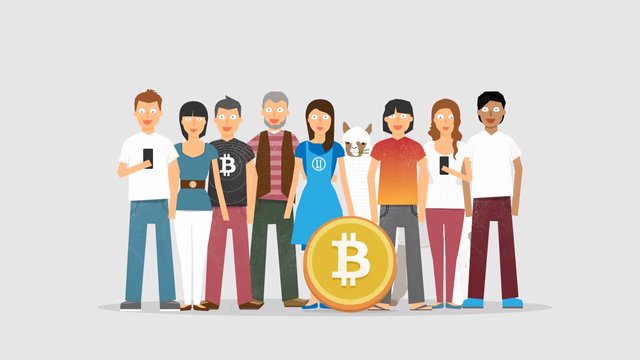Part 1/8: Bitcoin and the Blockchain
Introduction to Bitcoin

Image from bitcoin.org
For the longest time, I couldn't get my head around Bitcoin. It also seemed like noone else could, either; whenever I asked questions about Bitcoin and the technology, I got different answers.
After reading a number of books, discussing bitcoin and blockchain with a variety of people, and studying the Bitcoin source code, I was finally able to answer all the questions I had, such as:
What is bitcoin, exactly?
How can a virtual currency have value?
How do you mine a bitcoin?
What is blockchain? How is it different from bitcoin?
How can you split a single bitcoin into smallest denominations?
I'll be posting a series of articles discussing bitcoin, the blockchain technology is it build on, and answering the above questions, and more. I will try to go into specifics as possible: I like to know exactly how something works, including the nitty gritty details. The series will look something like this:
Part 1 - Introduction to Bitcoin (16th Jan 2018)
Part 2 - How Bitcoin Works
Part 3 - Keys, Addresses, Wallets
Part 4 - Transactions
Part 5 - The Bitcoin Network
Part 6 - The Blockchain
Part 7 - Mining
Part 8 - Conclusion and Recommended Further Reading
The best book to get more information is Mastering Bitcoin, but it's a heavy read aimed at programmers, so I'll take the important parts and explain in a concise yet detailed fashion. I hope to write future series for Ethereum, Steem, and more, as I learned more about each.
1. What is Bitcoin?
Bitcoin, is actually a few things: a currency, a technology network, and a software platform. These three units come together and form a digital ecosystem.
Users on the bitcoin network (known as nodes) generally communicate with each other over the Internet, however other transportations means are possible.
Bitcoin can be bought and sold on exchanges like bitFlyer, Coinbase and many others, just like real world currencies (sometimes called fiat in the cryptocurrency world).
Unlike real world currencies, however, there are no bitcoins as such. bitcoin is entirely virtual. Coins are implied by transations between users. Bitcoin is based on algorithms and protocols developing by crytography, the practice and study of secure communications in the presence of third parties. With bitcoin, owners use keys to send and receive bitcoin, and the prove ownership of transactions.
One of the big selling points of Bitcoin is decentralization. Unlike real world currencies, which are controlled by banks and governments, bitcoin data is hosted and stored across thousands of nodes, all over the world. Any node running the full bitcoin protocol stack can also be a miner.
Bitcoins are created through a process known as mining. Mining involved using computing power to find the solution a complex mathematical problem. Specifically, in bitcoin, miners are trying to find a solution to the (SHA-256)[https://en.wikipedia.org/wiki/SHA-2] hash function, with a network wide set difficultly (more on this later).
Every 10 minutes or so, a new solution is found. The miner is then able to use the solution to validate the past 10 minutes of transactions, and it rewarded with some new bitcoins. Thus, new bitcoins are "mined". This is how bitcoins are created. The reward halves every four years. This solves another real world currency problem, where governments print more money, and the value of existing money decreases. This is known as inflation.
The next part of the series will flesh out how bitcoin works. Stay tuned for more, and let me know if I've made any mistakes, or something isn't clear.
Here is a list of terms that I'll be using throughout this series.
Glossary
Address (Public key)
A bitcoin addres and a bitcoin public key are the same. They look like a bunch of random letters and numbers. A public key always starts with a 1.
Bitcoin
This can refer to three things: the currency (I have one bitcoin), the network (the bitcoin network, connected by computer running the bitcoin software called nodes), and the software (I installed bitcoin on my computed).
Block
A block is a group of transactions. It is marked with a timestamp and has a reference to the previous block. The header is hashed to find a "proff of work", which validates the transaction. A valid block is added by "network consensus", which enough nodes agree the block is valid.
Confirmation
One a transaction is included in a block, is has "one confirmation". When another block is added, it has two confirmations. Six or more is considered the point where the transaction cannot be reversed.
Fees
The sender of a transaction includes processing fee for the network to pay. Generally this is the minimum fee of 0.5m BTC, or 20 satoshis.
Hash
An "digital fingerprint" of some input, that cannot be reverse engineered.
Miner
A person running a computed on the bitcoin network) who finds valid proof of work for new blocks, by repeated hashing.
Proof of work
A piece of data that is computationally difficult to find. Specifically, miners, by brute force, find a solution to a hash algorithm that meets the difficulty set by the network.
Satoshi
The smallest unit of a bitcoin. 1 satoshi = 0.00000001 BTC, or 1/100 000 000.
Secret key
The corresponding key to the public key (bitcoin address). It is used to send bitcoin to the public key, and the public key only. A secret key looks looks like a bunch of random letters and numbers.
Wallet
Software that stores your bitcoin addresses and secret keys. Used to send and receive bitcoin.
Very nice, simple introduction.
Thanks! I'll be going deeper in future articles. Did you notice anything you think could be improved?
Hey, great series. Thanks for posting.